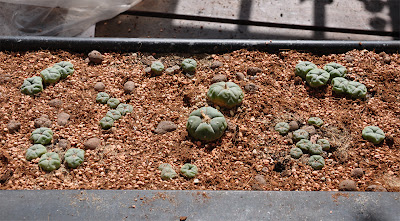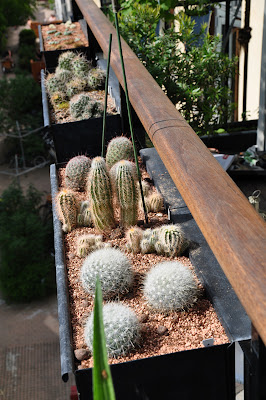40 peyote cacti growing in a window flower box
For the last many years I've experimented with growing peyote, Ariocarpus, Leuchtenbergia, and the likes in an unheated coldhouse in Denmark. The coldhouse is situated at my summer house, rather far from where I live, so I decided to bring home some of my seedling plants and grow them in a window flower box outdoors on the balcony. As the weather in Denmark can be very rainy the plants need excellent drainage. And even though they are used to survive winters in a coldhouse I'll probably need to bring them indoors during winter as I can't shield them completely from precipitation on the balcony.
Flower box planted with peyote and Acharagma
I waited for a sunny period (and a ditto long term weather report :-) before planting a window box with 40 peyote plants and a handful each of Acharagma aguirreana and Acharagma roseana plants.
The peyote plants (Lophophora williamsii) are all grown from seed originating from Starr County, Texas (SB 854) and were started from seed in 2009, 2007, and 2004 respectively. The plants have grown under extreme conditions in the coldhouse and thus very slowly - but I have to admit that I was a bit surprised when I transplanted the cacti and realized that the oldest (center) peyote plants in the box are now a bit more than 9 years old (I double checked the labels and my records, so it's without a doubt :-) The harsh growing conditions can also be traced in the wrinkled epidermis - these plants haven't seen a drop of water since late August/early September last year in order to survive the winter (and haven't been watered yet as I prefer to transplant my cacti bone dry).
Both Acharagma species were started from seed in spring 2009.
Drainage layer of Leca pebbles
I have never grown this type of cacti in window flower boxes before and was very much in doubt of what type of soil to use.
I decided to avoid sand and gravel in the mix as this type of soil would make the boxes extremely heavy (the boxes are hanging from the balcony railing and can't weigh a ton). Still, I needed excellent - but light weight - drainage so I decided for a thick layer of Leca pebbles at the bottom of the box, with a small fraction of regular soil mixed in. Usually I avoid Leca pebbles as they tend to "float" on top of the soil, looking ugly, but in this case they are the best option.
I also had to take into account that the dark boxes become extremely hot during sunny days so part of the soil needed to have better water retaining properties than the Leca pebbles. My solution was to use a top layer consisting of burnt moler cat litter and coir (a natural fibre extracted from the husk of coconut) - both are able to retain water but don't get soggy and waterlogged.
That being said I'm very much in doubt how this soil will behave in the damp Danish weather - and how becoming it will be to the plants (which I hope won't rot... but I'm sure time will tell :-)
Flower box planted with Echinocereus reichenbachii and Mammillaria
Another flower box was planted with Echinocereus reichenbachii originating from material I collected in the Wichita Mountains Wildlife Refuge back in 2007 plus a few Mammillaria grahamii (SB 1860; Steins, New Mexico, USA) and Mammillaria senilis (ROG 214; Tecorichi, Chihuahua, Mexico) plants bought from Kakteen-Haage.
I don't have much experience with growing Mammillaria species but selected these plants for their ability to tolerate cold conditions - and also for their beautiful flowers of course :-) One thing I learnt the hard way is that the fish hook spines of the Mammillaria plants behave like velcro when the plants get too close to each other, i.e. you should be very careful when planting several plants in the same container.
Three cacti window flower boxes on a row
I now have a total of three window flower boxes planted with cacti on the balcony; the two covered in this post plus the box planted with Echinocereus triglochidiatus, Escobaria vivipara (Alberta, Canada), and Escobaria missouriensis (SB204; Mesa County, Colorado). The latter box was planted last year and wintered outdoors on the balcony.
Saturday, June 08, 2013
Growing peyote (and other cacti) on the balcony
Thursday, February 21, 2013
Peyote purple from extreme cold

Purple peyote seedlings - a sign of extreme conditions
A purple colored epidermis is a common stress indicator for a number of cacti - stress caused either by cold or draught - and consequently can be seen as a sign of extreme growing conditions.
The peyote seedlings in the above photo haven’t seen a drop of water since late August/early September, i.e. they have been without water for almost half a year. And the last time I checked, the temperature in the coldhouse where the seedlings grow had been as low as -10C (14F). Extreme conditions for peyote seedlings indeed! And the explanation for their purple hue.
The plants are grown from seed originating from El Oso, Coahuila, Mexico. Given the locality and the seedlings’ ability to endure extreme cold and dry conditions I expect them to be Lophophora williamsii var. echinata.
Speaking of purple Lophophora williamsii var. echinata the below photo was posted a while ago by Keeper Trout. The picture shows a patch of mature peyote turned purple by the cold. According to Trout, the area in Texas where the plants grow had experienced a "hundred year freeze" including three days where the highest temperature measured at a nearby locality was 10F (less than -12C).

Purple peyote in habitat in Texas
The frost in western Texas killed off a lot of things considered freeze-hardy - including the dead peyote pictured below. This plant was from a different population than the purple patch pictured above and might have seen slightly colder temperatures, but still it’s a good indication that the freezing temperatures these plants experienced are at the limit of what Lophophora williamsii var. echinata will stand.

Dead peyote in habitat in Texas
As mentioned at the beginning of this post a purple tinted epidermis is a common sign of stress in many cacti. Another example from my coldhouse is the purplish-hued Ariocarpus retusus pictured below.

Purple tinted Ariocarpus retusus (SB 310; Cuesta la Muralla, Coahuila)
The mature peyote photos are courtesy of Keeper Trout and the Cactus Conservation Institute and originate from this post on The Corroboree.
Tuesday, February 12, 2013
Peyote, Ariocarpus and Normanbokea in the depth of winter

Winter dormant peyote cactus
Following a relatively mild period the last couple of years have seen freezing cold winters here in Denmark - winters that have been tough to my coldhouse grown plants, and especially the deep frost of 2009/2010 killed off a significant number of my coldhouse collection. But it also separated the wheat from the chaff leaving a pretty cold-hardy assemblage of plants, the dormant Lophophora williamsii var. echinata (JJH 8608293; Pecos River area) pictured above being a majestic example.

Ariocarpus kotschoubeyanus var. macdowellii (SB 100; El Pilar, Coahuila)
Most of the cacti growing in the coldhouse are selected for their (sometimes assumed) ability to survive freezing conditions. For example I prefer the Trans-Pecos variety of peyote as it is more frost hardy than the tender regular variety - and the different Ariocarpi all originate from the northernmost part of the species’ respective ranges.

Ariocarpus fissuratus (SB 403; Crockett Co, Texas)
Even though the cacti already have survived several cold winters I can’t deny that I still worry what plants will die off during winter (as some inevitably will).
The pictures appearing in this post were taken between Christmas and New Year - at that time the plants had already been exposed to temperatures in the vicinity of -10 C (approximately 14 F). Since then they have seen both mild and humid weather and long periods of frost - I expect that these fluctuations in temperature are harder to cope with for the plants than uniform periods of cold, but it’s just a hunch. Anyway I’m eagerly looking forward to spring :-)

Ariocarpus retusus (SB 310; Cuesta la Muralla, Coahuila)
But it is not just the cold that poses a threat to my plants. Previously critters have eaten large bites out of some of my peyote plants and now several of my Normanbokea valdeziana plants have met the same destiny... I still haven’t figured out what culprit is eating my cacti (or at least tasting and spitting out again)!

Normanbokea valdeziana (SB 1468; Ramos Arizpe, Coahuila, Mexico) eaten into by some unknown critter
Thursday, July 22, 2010
Trans-Pecos peyote with fruit – it’s an echinata!
It’s that time of year again. Most of my peyote plants have flowered freely all through summer and now the eagerly awaited results, the fruits, are appearing (many of my plants are still flowering so I’m hoping for a good seed harvest this year ;-)
Fortunately the majority of my coldhouse grown Trans-Pecos peyote plants (Lophophora williamsii var. echinata) survived this winter’s harsh frost (contrary to my “regular” Lophophora williamsii growing in the same unheated greenhouse – most of these plants succumbed to the frost).
Trans-Pecos peyote with fruit
The first fruit appeared on one of the surviving Trans-Pecos peyote plants only a few days ago. I’m looking forward to growing these seeds as the parent has a proven record of frost hardiness and I expect this trait to be inherited by its offspring (I’m using the singular “parent” as I assume this fruit to be the result of selfing; it only contained two seeds). Hopefully many of the cold grown Lophophora williamsii var. echinata plants will set fruit during the next couple of months ;-)
Trans-Pecos peyote with fruit, top view
I’ve been made aware that my use of the echinata epithet is not entirely clear. To clarify, I’m using it in the sense of Del Weniger – others, e.g. Backeberg, are incorrectly (IMHO) using echinata to describe what seems to be diffusa.
In his book Cacti of the Southwest Del Weniger describes L. williamsii var. echinata as being a larger, tougher form of the species, having heavier and larger stems and not clustering to any marked degree (possibly with a higher mescaline content also). Furthermore the echinata variety is described as being much more tolerant to extreme temperatures, both hot and cold (Weniger writes: “This form is found growing on dry, exposed hillsides of the Big Bend where the lower Rio Grande Valley form would be burned to a crisp. It can also survive the much more severe cold of the Big Bend. I have several times had the smaller form from south Texas freeze in San Antonio, while this form growing in the same bed showed no ill effects”). The range of the echinata variety is given as “Northern Mexico, extending from Chihuahua and Coahuila into the Texas Big Bend in lower Brewster County”.
Trans-Pecos peyote fruit, close-up
I have to admit that I find it rather difficult to clearly distinguish the echinata and regular williamsii forms based on morphology alone, especially young cultivated plants. So I rely heavily on locality information when buying seeds and to play it safe I prefer material originating from the Trans-Pecos region of Texas, the northernmost extreme of the Lophophora genus’ range.
But as my horrible experience this winter showed the echinata variety (in this case Lophophora williamsii var. echinata JJH 8608293; Pecos River area, Val Verde County, Texas) definitely seems to be more frost hardy than the regular williamsii variety.
Thursday, June 17, 2010
Peyote seedlings – Big Bend, Texas and Camargo, Chihuahua varieties
Late last year I ordered my first seed ever from Köhres-Kakteen (coinciding with ordering my first ever Lophophora alberto-vojtechii seeds ;-)

Dichotomous peyote seedling (var. Big Bend, Texas)
After this winter’s freezing disaster I’m glad I decided to order seeds of the northernmost form of peyote as this “strain” (a.k.a. Lophophora williamsii var. echinata) is known to be more frost tolerant than other varieties of peyote. For growing in my coldhouse I ordered Lophophora williamsii v Big Bend, Texas and Lophophora williamsii v Camargo, Chihuahua seeds from Köhres’s list – I’m not entirely sure if the Camargo variety classifies as echinata but it originates from the western extremity of peyote’s range, pretty far to the north, so I expect it to be able to “rough it out” in my unheated greenhouse.

Dichotomous peyote seedling (var. Big Bend, Texas), close-up
One of the “Big Bend” peyote seedlings turned out as dichotomous (branching, two-headed). The first time I experienced a dichotomous seedling I was really excited and expected it to continue branching and develop into a crest. Today I know that in a few years I will probably not be able to distinguish it from the other seedlings in the (by then) crowded seedling pot ;-)

Peyote seedling (var. Camargo, Chihuahua) with spent seed husk
The small, feathery spines are typical for Lophophora williamsii seedlings – according to Boke and Anderson seedling tubercles bear three to six plumose spines, numbers that correspond well with what I observe in my seedlings (the odd areole having seven spines). With age these spines are gone, replaced by tufts of trichomes.
The plants pictured above were started from seed April 5, 2010 and the pictures were taken June 14, 2010 – exactly 10 weeks later (approximately two months after most of the seed had germinated).
Wednesday, April 28, 2010
The power of grafting – 6th anniversary
A week ago my grafted Lophophora williamsii (SB 854; Starr Co, Texas) celebrated its 6th anniversary sitting on top a sturdy Trichocereus pachanoi stock. The plant was grafted as a tiny seedling and in 6 years the main head has grown to a width of approximately 8 cm (~3.2'') – the 3 largest offshoots are 6 cm (~2.4'') wide each. The main head seems to have stabilized at 8 ribs while the largest pups are in transition from 5 to 8 ribs.

Lophophora williamsii graft, top view
The last couple of weeks the plant has “popped out” fruits resulting from last years late flowers. This season’s first flower appeared a couple of days ago and was promptly (self-)pollinated – according to previous experience this should result in another fruit in 7-8 weeks time.

Grafted Lophophora williamsii, first flower of the season
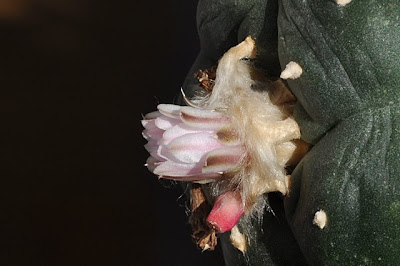
Lophophora williamsii flower and fruit
I’ve already harvested more than 120 seeds from this plant alone this season. As this variety of Lophophora williamsii is not particularly frost hardy I’m not sure if I’ll start all these seeds as the seedlings will have to go to my coldhouse – maybe I should set up a “swap shop” instead ;-)

Lophophora williamsii fruits
I’m wondering for how long the Trichocereus pachanoi stock will be able to support the rather large Lophophora williamsii scion. This is my oldest graft so I have no experience to rely on regarding the actual longevity of Trichocereus stock plants; I guess time will tell.

Lophophora williamsii grafted on Trichocereus pachanoi stock
For comparison you can check the posts on the same graft as one, two, three, four, and five years old.
Wednesday, April 21, 2010
The killing frost – life goes on
As mentioned in two previous posts (available here and here) this winter was extremely cold and killed off large parts of the collection I grow in an unheated greenhouse. Now spring is comming and the surviving plants are getting ready to move on.
Lophophora williamsii var. echinata with fruit
Most of my Trans-Pecos peyote plants (Pecos River area, Val Verde County, Texas; JJH 8608293) made it through the winter and is now setting fruit as if to herald the beginning of the comming growing season. If you look closely you’ll even notice a few flower buds.
Trans-Pecos peyote with budding flower
The Trans-Pecos peyote is also known as Lophophora williamsii var. echinata and is more cold-hardy than other varieties of L. williamsii
My Epithelantha micromeris plants (near Belen, New Mexico; SB1327) are also busy securing the next generation.
Epithelantha micromeris with fruit, top view
I’m getting increasingly infatuated with Epithelantha - you can’t but love the complex spination and the almost shocking pink fruits ;-) As Epithelantha has also proven to be an extremely cold hardy genus I’ll probably add more of these plants to my collection in the future.
Epithelantha micromeris with fruit
I am growing these plants at my summerhouse and not seeing them as often as I could wish. Unfortunately this also means that I miss a lot of the flowers including those of the Normanbokea valdeziana and Acharagma roseana pictured below.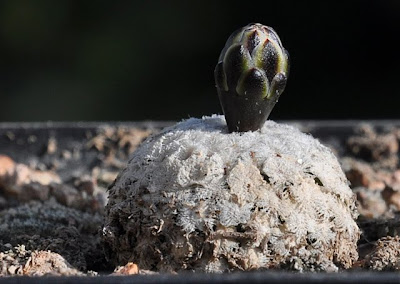
Normanbokea valdeziana about to flower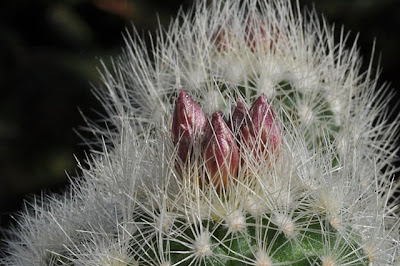
Acharagma roseana about to flower
Fortunately fruits are more persistent than flowers giving me the opportunity to enjoy sights like the orange-red berries of Escobaria missouriensis (Mesa County, Colorado; SB204)
Escobaria missouriensis with fruit
My Maihuenia patagonica are thriving after the winter but not exactly flowering or setting fruit. I don’t have much experience growing Maihuenia - I originally fell for Maihuenia poeppigii but being a completist I ordered M. patagonica seeds as well. All the M. poeppigii plants succumbed to the frost this winter while the M. patagonica plants only suffered a few casualties. I'm not sure I’m treating the plants right, though, as they are growing strangely lanky, far from the dense, clustering habit I have seen in pictures (and the plants are getting plenty of light).
Maihuenia patagonica
And now for something completely different.
My summerhouse is located on the west coast of Denmark overlooking the North Sea. This weekend the Sun set in a sky looking much more orange than usual, and slightly diffused as by a thin haze. 
The Sun setting in a haze of ashes from the Eyjafjallajökull eruptions
I take this to be caused by the Eyjafjallajökull volcano eruptions that have been sending a vast, invisible plume of grit drifting over Europe and kept most of European airspace shut down for several days. Of course one could imagine that a sunset like this was caused by a thin layer of clouds, but I have enjoyed hundreds of sunsets from my terrace and never seen anything like this before.
Sunset with a diffuse halo of refracted light – probably caused by Eyjafjallajökull ashes
On a different note, the Eyjafjallajökull volcano eruptions almost got me stuck in Amsterdam (not the worst place to be stuck in, by any means ;-) I and a colleague were supposed to have flown home in the late evening of April 15, 2010 – but as we watched more and more flights getting canceled and increasing parts of the north-western European airspace being closed down we agreed to rent a car. So in the early afternoon we set out on a long drive home – which in hindsight was an extremely wise decision as Danish airspace is only opening again today ;-)
Sunday, April 11, 2010
The killing frost – casualties and survivors
First a bit of background information so that you guys won’t believe that I am completely stupid growing Lophophora and the likes in an unheated greenhouse in Denmark: 1) Most of these plants are “surplus”, i.e. I don’t have room for them anywhere else – lately several plants have been bought specifically for the cold house, though. 2) The greenhouse is located at my summerhouse, left mostly desolate throughout winter, making it difficult to keep it reliably heated. 3) Many cactus species tolerate more frost than is generally assumed; I’m curious which. 4) The winters in Denmark have been rather mild lately, inviting experiments like this.
With this in place I’m ready to recount how the harsh winter, that has just released its cold grip of Denmark, helped me separate the wheat from the chaff (a blatant euphemism for “killing off alarmingly large parts of my collection”). Just to give an understanding of the severity of the winter, the plants saw almost constant frost for more than 10 weeks, with temperatures measured as low as -15 C (5 F) in the area where the plants grow.
Lophophora williamsii var. echinata coming out of winter
Let’s start with one of the success stories. My Trans-Pecos peyote plants are doing quite well, approximately one in eight died and the surviving plants are not too marked by the frost. The plants I'm growing are descending from material originally collected in the Pecos River area, Val Verde County, Texas (JJH 8608293). The Trans-Pecos peyote is the northernmost form of Lophophora williamsii and is also known as Lophophora williamsii var. echinata.
Trans-Pecos peyote surviving the frost
My regular (Mexican and south Texan) Lophophora williamsii plants fared much worse, less than one in ten of the larger plants survived the winter. 
One of the few surviving Lophophora williamsii var. williamsii
This corresponds well with Del Weniger’s observations:
[Lophophora williamsii var. echinata] can also survive the much more severe cold of the Big Bend. I have several times had the smaller form from south Texas [L. williamsii var. williamsii] freeze in San Antonio, while this form [L. williamsii var. echinata] growing in the same bed showed no ill effects.
In the future I'll focus more on the extreme northern forms of peyote, i.e. plants grown from material originating from Shafter, Val Verde, Big Bend and other Trans-Pecos, Texas locations. The Cactus Conservation Institute has an informative page on the differences in traits between Lophophora williamsii var. echinata and var. williamsii.

Frost killed Lophophora williamsii, Starr County, Texas
As mentioned the majority of my large “regular” Lophophora williamsii were killed by the frost. But many medium sized seedling plants actually survived while the larger plants (of the same variety) and yearling seedlings succumbed. As this pattern seems to be rather consistent for plants of the same variety, I guess I can’t write all “regular” Lophophora williamsii casualties off to genetics. My theory is that this “size-conditioned” difference in survival must be related to how well the plants were prepared for the winter, which again may be closely related to the surface-area-to-volume ratio of the plant.
The surface-area-to-volume ratio (SA:V) decreases with size, i.e. a large plant will have less surface per unit of volume than a smaller plant. If we use a half sphere as a model for a globular cactus we get a SA:V of 3/r, where r is the radius. Consequently a large plant will need relatively longer time (per unit of volume) to go flaccid and prepare properly for the winter (as all excess water needs to be evaporated through the surface (the epidermis)). Similarly seedlings are more prone to die of drought as an increased SA:V means increased exposure to the environment in general.
To play it safe the coming growing seasons I'll stop watering my large plants well before I let seedlings go drought dormant in preparation for the winter, and in general start winter preparations earlier than I have used to in the past.
I might consider crossing the surviving mature (non Trans-Pecos) plants and name the cultivar Lophophora williamsii 'Borealis' ;-)

Frost killed Leuchtenbergia principis – outside the rain is weeping
My largest Leuchtenbergia principis is dead (pictured above next to a surviving saguaro) while 3 out of 4 of my smaller Leuchtenbergia principis plants (GL 770; Sierra de la Paila) are looking happy.
Ariocarpus has turned out to be an unconditional coldhouse success. I expected my Ariocarpus fissuratus plants to make it safely through the winter as they originate from locations like Fort Stockton, Texas (JM 122) and Crockett County, Texas (SB 403), but I had doubts about my Ariocarpus kotschoubeyanus var. macdowellii plants (SB 100; El Pilar, Coahuila), and had accepted that I would probably loose my Ariocarpus retusus (SB 310; Cuesta la Muralla, Coahuila). Amazingly they all survived the winter in great style almost looking lush and vigorous, like a winter swimmer surfacing with renewed energy after a cold plunge.

Surviving Ariocarpus, Epithelantha, and Leuchtenbergia plants
Epithelantha is another seriously cold tolerant genus. My Epithelantha micromeris var. greggii plants (Cuesta la Muralla, Coahuila, Mexico) all made it; one is seriously damaged, though – it looks like the root is dead while the crown looks fine, so I hope to be able to re-root it. The Epithelantha bokei plants (SB 416; Brewster Co, Texas) also look fine, but due to the extremely dense spination it is hard to say for sure if they are completely undamaged. Strangely the cold has taken the hardest toll on my regular Epithelantha micromeris (SB1327; near Belen, New Mexico) – this variety of E. micromeris is from the northernmost known locality of the species so I had expected the plants to cope better with the frost.

Surviving Obregonia denegrii plants
Last summer I moved a handful of Obregonia denegrii seedlings (VVZ 163; San Vicente, Tamaulipas) to the coldhouse. I really didn’t expect these plants to be cold hardy, but didn’t have room for them anywhere else. Surprisingly approximately two thirds of the plants survived as illustrated in the above picture (the surrounding pots are not empty, each contain a rather large L. williamsii killed by the cold).
Other success stories are Normanbokea valdeziana, Homalocephala texensis, and Mammillaria meiacantha which all made it through the winter without casualties – the Normanbokea plants are even budding. Acharagma roseana is another species that’s shaking off the winter blues and getting ready to bloom – in general Acharagma seems to handle the cold pretty well, even most of my yearling Acharagma aguirreana seedlings survived. Most Escobaria and Echinocereus obviously had minimal problems with the frost.

Frost killed Lophophora williamsii turning to mush
As mentioned above the majority of my larger, regular Lophophora williamsii plants were killed by the frost, but the more tender Lophophora species like Lophophora diffusa and L. fricii are completely eradicated – I’ll probably not experiment further with these species in the coldhouse, the exception maybe being montane varieties of Lophophora fricii.

Dead Lophophora diffusa
Other species that are completely wiped out include Matucana madisoniorum, an unknown Echinopsis hybrid, Ferocactus glucescens (PP 1354), Lithops lesliei (not exactly a cactus, I know ;-), and Harrisia jusbertii. Surprisingly all my Mammillaria grahamii also died – I had expected this species to be more cold hardy.
Most of my saguaro cactus (Carnegiea gigantea) also succumbed to the frost – 4 plants look like they might survive, most of them badly damaged, but it is too early to say.
I need to start building a new collection of grafting stock – all Trichocereus plants that I grew in the coldhouse are dead, including Trichocereus pachanoi, T. peruvianus, Trichocereus 'Tom Juul’s Giant', and a Penis Cactus… they are all gone. Even plants that were well prepared for the winter died, so Trichocereus is definitely not as tolerant to frost as I had expected.
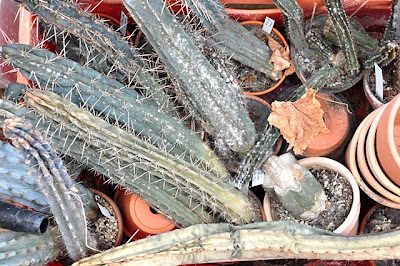
Decomposing Trichocereus plants
To put the death toll into perspective this is the coldest winter in 14 years in Denmark (followed by March, a month with the most extreme temperature fluctuations in 14 years, which were not very becoming to my struggling plants either). The frost set in just before Christmas and only lifted again in the beginning of March. The lowest temperatures measured in the area were as low as -15 C (5 F).

Outdoor temperature in late January
Once in a while short bursts of thaw set in quickly followed by frost (as indicated by the above graph), making the conditions even harder for the plants.

Outdoor temperature in mid February
The temperature measurements come from a semi-professional weather station located approximately 1.5 km (~ one mile) from where I grow my plants, so these temperatures are representative for those that my plants where exposed to.
To end on a positive note I expect the frost to have killed off many pests also (including red spider mites). Also, I got an affirmative confirmation that it is actually possible for peyote to survive rather extreme conditions in an unheated greenhouse in Denmark... and I got plenty of room for new plants ;-)
Tuesday, December 29, 2009
The killing frost
The fact that the last many winters have been mild in Denmark has made me act with presumption, ignoring several basic rules for growing cacti in freezing conditions. The week before Christmas Denmark was hit by an early cold spell, bringing hard frost that made many of my coldhouse grown plants suffer the consequences of my folly.
Frozen Lophophora williamsii (SB 854; Starr Co, Texas)
The family spent the Christmas holidays in the summerhouse arriving late December 21, the day of the winter solstice. Of course I had to check up on my plants in the coldhouse first thing, but was met by a disheartening sight: The beautiful turgid, dark jade green Lophophora williamsii plants pictured above are frozen solid.
Lophophora williamsii draped in horticultural fleece
The greenhouse walls are covered with curtains and the plants are draped in horticultural fleece to protect them from the cold, still the temperature was measured to slightly less than -7 C (~ 19 F) just next to the plants. The temperature alone shouldn't be a problem as these plants have endured conditions in the coldhouse since 2004 (actually these very plants started my experiments in Lophophora cold hardiness so I'm double sad to loose them), but freezing conditions combined with plants that haven't had the time to go flaccid before subjected to the frost is a deadly cocktail. I'm sad to admit that I watered the above Lophophora williamsii plants along with a couple of Gymnocalyciums and two large pots of 3 year old L. williamsii seedlings very late in the season (late September). To make things worse October and November came with a perpetual overcast sky and constant, high humidity levels, leaving the plants no chance to dry out thoroughly. Finally, to top things off, December brought very early and double digit freezing temperatures (measured in celsius) killing off the plants still bloated with water. I have learned my lesson and will never water any of my coldhouse plants later than the end of August (the exception being very young seedlings that might otherwise succumb to drought).
Thawed Lophophora williamsii (SB 854; Starr Co, Texas)
Come Boxing Day the frost went away, leaving me with thawing plants and the possibility to asses the damage – unfortunately I had to leave for home the day after, so the exact casualty figures will follow in a later post.
The thawed Lophophora williamsii plants pictured above felt soft and slightly mushy to the touch but I didn't have the heart to squish them to see if they were fluid inside.
Thawed Lophophora williamsii seedlings
The two large pots of 3 year old Lophophora williamsii seedlings are gone for sure. Upon thawing the seedlings first felt like small bags of slush ice before the interior turned completely fluid. Subjected to a light pressure the epidermis broke and liquid oozed out, indicating that the cell walls are lacerated by the frost.
Frost killed Lophophora diffusa
Another mistake I made was to move new plants into the coldhouse without leaving them sufficient time to acclimatize properly for the winter – the plants were moved to the coldhouse in late September/early October. On that account I lost 3 large Lophophora diffusa like the one pictured above.
As is evident from the flaccid (and very much alive) L. diffusa pictured below, these plants are able to survive the cold conditions if treated properly. The two plants are from the same batch, are growing under the same conditions (and the pictures were taken the same day). The only difference being that the survivor was given proper time to adjust to its harsh environment.
Alive Lophophora diffusa
I also recently introduced a handful of new Ariocarpus plants to the coldhouse – they had me somewhat worried but seem to cope. 
Frost damaged Penis Cactus
My last mistake was to leave a collection of columnar cacti out on the terrace until mid October, exposing them to precipitation and moisture for much longer than what's healthy for plants that must winter in freezing conditions. This has taken its toll on my formerly so erect Penis Cactus - I'm not sure if the plant is completely killed off by the frost but it is certainly damaged. I'm worried for the rest of my Trichocereus collection also; many of the plants felt completely frozen to the touch but are not showing any evident signs of damage yet – time will tell, though.
The lesson I have learned from this experience is to always expect the worst from the weather and prepare accordingly (which should have been evident in the first place!). Even if the last many winters have been mild, I should have known that frost can set in suddenly and quite early in Denmark – instead of being lulled into the assumption that most of the winter would be mild with hard frost arriving late, as the situation has been the last few years. I won't be that careless in the future.
After a couple of mild days the weather reports again predict a period of hard, day- and nighttime, frost extending into the new year.
Update, April 11, 2010
Read more about the casualties and survivors of the frost.
All Time Most Popular Posts
-
Lophophora williamsii (peyote) populations have diminished in large areas of South Texas where peyoteros harvest the cactus for ceremonial ...
-
On various occasions I've been asked what growing media I'm using for my cactus plants. I don't have a set soil mix recipe as su...
-
Below is a list of retailers/nurseries selling cactus seed and plants. I've only listed vendors I've done business with. If you ar...
-
Most cacti are easily grown from seed - and with a little patience and care they can be grown into beautiful plants. Lophophora williamsi...
-
In last month’s post on the troubled Texan peyoteros I referred to Anderson’s article on the peyote situation in Texas. Given the importanc...
-
Yet another slightly off topic and probably not entirely politically correct post, but I couldn’t help noticing the similarity of my monstr...
-
Flowering stand of San Pedro cacti (Trichocereus pachanoi) To me the main draw of the San Pedro cactus ( Trichocereus pachanoi (syn. Ech...
-
In the June 2008 issue of the Cactus & Co magazine Jaroslav Šnicer, Jaroslav Bohata, and Vojtěch Myšák described a new Lophophora spec...
-
There seems to be an increased focus on the alarming Texas peyote situation. A couple of weeks ago the Houston Press published a mournful, i...
-
I spent two weeks working in Delhi, India during January. I had one weekend off and had planned to spend it in Delhi at my own leisure, but ...
